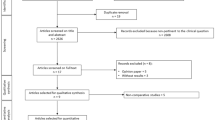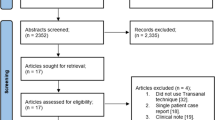Abstract
Background
Delayed colo-anal anastomosis (DCAA) has received renewed interest thanks to its reduction in anastomotic leakage rate without the use of stoma to protect a low rectal anastomosis. The aim of this review was to summarize the available literature on DCAA following rectal cancer resection and to report clinical, oncological and functional results.
Methods
A comprehensive literature review was conducted including MEDLINE/Pubmed, EMBASE, SCOPUS, clinicaltrials.gov and the Cochrane database of systematic reviews through July 2018. The review was conducted according to MOOSE guidelines. Quality was appraised with the methodological index for non-randomized studies (MINORS) tool.
Results
Eight observational studies (409 patients) were included. Average MINORS score was 9.6/14 in seven non-comparative studies and 17/22 in one comparative study. Six studies reported no anastomotic leak. Pelvic sepsis/abscess ranged from 0 to 25%. Mortality rate was <3% in seven studies and 12.5% in one. Poor fecal continence was reported in <30% of patients. Need for permanent stoma was ≤2% in six studies. A five-year survival rate ranged from 63.8 to 81% (four studies). Loco-regional recurrence rate ranged from 4.8 to 14.3% at 3 years (four studies) and from 6 to 38.8% at 5 years (three studies).
Conclusion
DCAA offers an alternative to primary straight colo-anal anastomosis for low rectal cancer. The benefits include reduced risk of anastomotic leakage and pelvic sepsis, and no need for protective ileostomy, with good functional and oncological outcomes. Results of ongoing randomized controlled trials comparing DCAA with straight colo-anal anastomosis and protective stoma are awaited to draw definitive conclusions.


Similar content being viewed by others
References
Qu H, Liu Y, Bi DS (2015) Clinical risk factors for anastomotic leakage after laparoscopic anterior resection for rectal cancer: a systematic review and meta-analysis. Surg Endosc 29:3608–3617
McDermott FD, Heeney A, Kelly ME et al (2015) Systematic review of preoperative, intraoperative and postoperative risk factors for colorectal anastomotic leaks. Br J Surg 102:462–479
Matthiessen P, Hallböök O, Rutegård J et al (2007) Defunctioning stoma reduces symptomatic anastomotic leakage after low anterior resection of the rectum for cancer: a randomized multicenter trial. Ann Surg 246:207–214
Hüser N, Michalski CW, Erkan M et al (2008) Systematic review and meta-analysis of the role of defunctioning stoma in low rectal cancer surgery. Ann Surg 248:52–60
Turnbull RB Jr, Cuthbertson A (1961) Abdominorectal pull-through resection for cancer and for Hirschsprung’s disease. Delayed posterior colorectal anastomosis. Cleve Clin Q 28:109–115
Cutait DE, Figliolini FJ (1961) A new method of colorectal anastomosis in abdominoperineal resection. Dis Colon Rectum 4:335–342
Hallet J, Milot H, Drolet S et al (2014) The clinical results of the Turnbull–Cutait delayed coloanal anastomosis: a systematic review. Tech Coloproctol 18:579–590
Stroup DF, Berlin JA, Morton SC et al (2000) Meta-analysis of observational studies in epidemiology: a proposal for reporting. Meta-analysis of observational studies in epidemiology (MOOSE) group. JAMA 283:2008–2012
Slim K, Nini E, Forestier D et al (2003) Methodological index for non-randomized studies (minors): development and validation of a new instrument. ANZ J Surg 73:712–716
Kirwan WO, Turnbull RB Jr, Fazio VW et al (1978) Pullthrough operation with delayed anastomosis for rectal cancer. Br J Surg 65:695–698
Olagne E, Baulieux J, de la Roche E et al (2000) Functional results of delayed coloanal anastomosis after preoperative radiotherapy for lower third rectal cancer. J Am Coll Surg 191:643–649
Facy O, Lagoutte N, Jambet S et al (2009) After low anterior rectal resection, colonic pull-through with delayed colo-anal anastomosis can avoid the need for a diverting stoma (Anastomose coloanale différée sans stomie de derivation après résection antérieure basse du rectum). J Chir 146:458–463
Jarry J, Faucheron JL, Moreno W et al (2011) Delayed colo-anal anastomosis is an alternative to prophylactic diverting stoma after total mesorectal excision for middle and low rectal carcinomas. Eur J Surg Oncol 37:127–133
Pujahari AK, Anand S (2015) Trans-anal exteriorisation of colon and delayed coloanal anastomosis for sphincter preservation in low carcinoma rectum. Int J Colorectal Dis 30:853–855
Bianco F, Belli A, De Franciscis S et al (2016) “Scarless” and no-stoma surgery for low rectal cancer: the laparoscopic pull-through delayed “high” colo-anal anastomosis. Updates Surg 68:99–104
**ong Y, Huang P, Ren QG (2016) Transanal pull-through procedure with delayed versus immediate coloanal anastomosis for anus-preserving curative resection of lower rectal cancer: a case control study. Am Surg 82:533–539
Sage PY, Trilling B, Waroquet PA et al (2018) Laparoscopic delayed coloanal anastomosis without diverting ileostomy for low rectal cancer surgery: 85 consecutive patients from a single institution. Tech Coloproctol 22:511–518
Bianco F, De Franciscis S, Belli A et al (2015) A pull-through delayed ‘high’ coloanal anastomosis: new tricks to refresh an old procedure. Tech Coloproctol 19:259–261
Remzi FH, El Gazzaz G, Kiran RP, Tirat HT, Fazio VW (2009) Outcomes following Turnbull–Cutait abdominoperineal pull-through compared with coloanal anastomosis. Br J Surg 96:424–429
Hallet J, Bouchard A, Drolet S et al (2014) Anastototic salvage after rectal cancer resection using the Turnbull–Cutait delayed anastomosis. Can J Surg 57:405–411
Patsouras D, Yassin NA, Phillips RK (2014) Clinical outcomes of colo-anal pull-through procedure for complex rectal conditions. Colorectal Dis 16:253–258
Fixot K, Galifet M, Scherrer ML et al (2014) Abdominoperineal pull-through resection with delayed coloanal anastomosis as treatment option for complex recto-urinary fistulas. Int J Colorectal Dis 29:407–409
Bell SW, Walker KG, Rickard MJ et al (2003) Anastomotic leakage after curative anterior resection results in higher prevalence of local recurrence. Br J Surg 90:1261–1266
Law WL, Choi HK, Lee YM et al (2007) Anastomotic leak is associated with poor long-term outcome in patients after curative colorectal resection for malignancy. J Gastrointest Surg 11:8–15
Cottam J, Richards K, Hasted A, Blackman A (2007). Results of a nationwide prospective audit of stoma complications within 3 weeks of surgery. Colorectal Dis 9:834–838
Sabbagh C, Rebibo L, Hariz H et al (2018) Stomal construction: technical tricks for difficult situations, prevention and treatment of post-operative complications. J Visc Surg 155:41–49
Gessler B, Haglind E, Angenete E (2012) Loop ileostomies in colorectal cancer patients: morbidity and risk factors for non reversal. J Surg Res 178:708–714
Sharma A, Deeb AP, Rickles AS et al (2013) Closure of defunctioning loop ileostomy is associated with considerable morbidity. Colorectal Dis 15:458–462
Brown S, Margolin DA, Altom LK et al (2018) Morbidity following coloanal anastomosis: a comparison of colonic J-pouch vs straight anastomosis. Dis Colon Rectum 61:156–161
Tekkis P, Tan E, Kontovounisios C et al (2015) Hand-sewn coloanal anastomosis for low rectal cancer: technique and long-term outcome. Colorectal Dis 17:1062–1070
Bryant CL, Lunniss PJ, Knowles CH et al (2012) Anterior resection syndrome. Lancet Oncol 13:e403–e408
Keane C, Wells C, O’Grady G et al (2017) Defining low anterior resection syndrome: a systematic review of the literature. Colorectal Dis 19:713–722
Hida J, Yasutomi M, Fujimoto K et al (1996) Functional outcome after low anterior resection with low anastomosis for rectal cancer using the colonic J-pouch. Prospective randomized study for determination of optimum pouch size. Dis Colon Rectum 39:986–991
Joo JS, Latulippe JF, Alabaz O et al (1998) Long-term functional evaluation of straight coloanal anastomosis and colonic J-pouch: is the functional superiority of colonic J-pouch sustained? Dis Colon Rectum 41:740–746
Ho YH, Seow-Choen F, Tan M (2001) Colonic J-pouch function at six months versus straight coloanal anastomosis at two years: randomized controlled trial. World J Surg 25:876–881. https://doi.org/10.1007/s00268-001-0044-1
Siegel RL, Miller KD, Fedewa SA et al (2017) Colorectal cancer statistics, 2017. CA Cancer J Clin 67:177–193
Author information
Authors and Affiliations
Contributions
GP, GOP, FC were involved in conception and design. GP, MP, FC contributed to the acquisition of data. GP, GOP, MP, FC analyzed and interpreted the data. GP, GOP, MP, FC drafted the manuscript. GP and FC revised the manuscript.
Corresponding author
Ethics declarations
Conflict of interest
The authors declare that they have no conflict of interest.
Additional information
Publisher's Note
Springer Nature remains neutral with regard to jurisdictional claims in published maps and institutional affiliations.
Electronic supplementary material
Below is the link to the electronic supplementary material.
Rights and permissions
About this article
Cite this article
Portale, G., Popesc, G.O., Parotto, M. et al. Delayed Colo-anal Anastomosis for Rectal Cancer: Pelvic Morbidity, Functional Results and Oncological Outcomes: A Systematic Review. World J Surg 43, 1360–1369 (2019). https://doi.org/10.1007/s00268-019-04918-y
Published:
Issue Date:
DOI: https://doi.org/10.1007/s00268-019-04918-y




